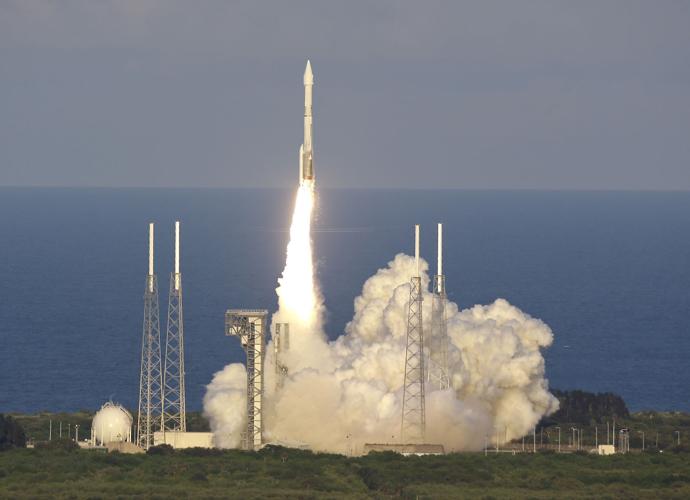OSIRIS-REx is headed for Bennu.
A United Launch Alliance Atlas V rocket bearing the OSIRIS-REx spacecraft — and the hopes of a small army of planetary scientists led by the University of Arizona — lifted from Cape Canaveral Thursday at 4:05 p.m. Tucson time, on time and without incident.
“We got everything just exactly perfect,” said Dante Lauretta, the mission’s principal investigator and a UA professor of planetary sciences.
Lauretta gave a big thumbs-up as the NASA panel was introduced at a post-launch news conference.
“This represents the hopes and dreams, hard work, blood, sweat and tears of thousands of people who have worked on this mission for over a decade,” he said.
A lot of the team was on-site Thursday, joining about 300 UA students, scientists, administrators and donors who watched from Kennedy Space Center.
In Tucson, hundreds of students and space enthusiasts gathered on the University of Arizona Mall to watch the mission blast off for Bennu.
They took seats in the grass, or crowded under a tent for shade, eyes turned to a giant screen broadcasting the launch. They grew silent as launch neared.
The only sound was that of a NASA spokesman narrating the live stream. When he announced that all systems were go, spectators applauded.
When the rocket lifted off, the crowd erupted into shouts and cheers, drowning out the televised rumbling of the spacecraft.
Ed Beshore, the mission’s deputy principal investigator, watched the launch with colleagues from a causeway at Kennedy Space Center.
“We have a beautiful, straight shot, a beautiful breeze, no mosquitoes, no clouds, it was just absolutely perfect,” he said by telephone shortly after launch as he watched the rocket roar into the sky.
Beshore said the launch was so bright and so spectacular that many in the crowd were too awed to cheer. “Our mouths were open, just watching it go up. It’s very, very cool.”
The launch was the end of a long chapter for the team. “I feel great,” he said. “There are just so many people who have worked so hard to this point. Now things get really exciting for lots of us right now.”
The spacecraft, whose scientific mission was conceived by scientists at the University of Arizona’s Lunar and Planetary Laboratory, will rendezvous with Bennu after a two-year, 2-billion mile journey.
Sling-shotting by Earth for a gravity assist, it will catch up to the mountain-sized space rock and then slow to fly in formation alongside it.
It will use an array of instruments to characterize its composition — a thermal spectrometer supplied by Arizona State University’s School of Earth and Space Exploration, a LIDAR altimeter from the Canadian Space Agency, a visual and infrared spectrometer from NASA Goddard, an X-Ray imaging spectrometer built by a student team at Harvard and MIT, and a suite of cameras built by the UA’s Lunar and Planetary Lab, which also hosts the mission’s Science Processing and Operations Center.
Those instruments will scrutinize the surface of Bennu to help scientists select the perfect site to gather a handful of loose soil with a telescoping sampler arm. The “regolith” will be returned to Earth in a sealed container in 2023.
OSIRIS-REx is the third of NASA’s New Frontiers missions, all led by unaffiliated principal investigators, in this case UA’s Lauretta, who has spent his career studying meteorites for clues to the formation of the solar system and the origin of life.
LPL scientists chose Bennu because it was close by and had the spectral signature of carbon, the essential element in organic compounds such as amino acids.
Return of the sample — at least 2.1 ounces of pristine space dust and as much as 4.4 pounds — will mark the beginning of a scientific investigation that will last decades.
That tiny sample, 75 percent of which will be stored for future analysis with improved techniques and instruments, is a time capsule of conditions that existed 4.5 billion years ago during the formation of the solar system.
The $1 billion mission was originally proposed as a less ambitious one by the late Michael Drake, former director of the Lunar and Planetary Lab at UA, who initially worked with colleagues at Lockheed Martin Space Systems on the proposal.
It took three tries, but Drake, who brought on Lauretta as deputy principal investigator, finally won an $803 million NASA contract, the largest ever won by the UA, in May 2011. Six months later, Drake died.
Lauretta said he thought of Drake often Thursday. “Today has been bittersweet. I really missed him,” he said.
A plaque honoring Drake is flying with the spacecraft and the scientific part of the mission will be run from the off-campus building now named the Michael Drake Building.
It once housed the Phoenix Mars Lander team, the first NASA mission led by the UA, and was reconfigured to accommodate up to 400 scientists from across the globe who will be present for critical operations of OSIRIS-REx.
It is not the only campus construction project spawned by the mission.
The sub-basement of the Kuiper Space Sciences building, built with NASA money during the Apollo era, is being retrofitted for vibration-free, atomic-level analysis of samples.
“The university has made substantial investment in cutting-edge equipment that will allow us to understand what the nature of that material is and what it means about the origin of life,” said Kimberly Espy, UA senior vice president for research.
Espy watched the launch with UA President Ann Weaver Hart. Espy said by phone afterward that the spectacle was overwhelming. “You see the fire, then you hear the sound, then you could really feel the shaking,” she said.
Timothy Swindle, current director of LPL, was excited at the prospect for those analyses when reached by phone shortly before launch.
“Personally, it’s just fascinating to watch something I’ve seen go from an idea 12 years ago to a launch pad today. At LPL, we’ve done all sorts of great things, but this might be the greatest. It’s a big deal,” he said.
Swindle’s counterpart at the UA’s Steward Observatory, Director Buell Jannuzi, said the mission is a boost for his department as well as the entire university.
“It’s a wonderful example of how the UA handles really challenging and ambitious efforts to expand our horizons and understand our universe. I’m really proud,” he said by telephone as he headed to the launch viewing Thursday.
He said astronomy and planetary sciences “have always been linked in developing new techniques.” He said that collaboration is growing as other solar systems are discovered.
“Studying exoplanets and searching for life on other worlds is common to both departments and reflected by our joint appointments,” he said.
Jim Green, director of NASA’s Planetary Sciences Division, was exuberant at the news conference.
“Planetary science is, for me, where it’s at and we just keep hitting it out of the ball park. Tonight, we hit it off the face of the Earth.”





